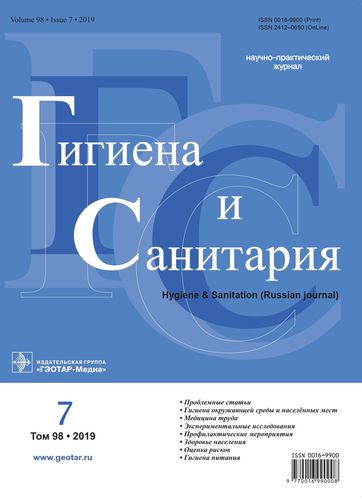Проблемы установления зависимости доза – эффект для оценки риска от воздействия ионизирующего излучения и вредных химических веществ
- Авторы: Коренков И.П.1, Дёмин В.Ф.2, Соловьёв В.Ю.1
-
Учреждения:
- Федеральное государственное бюджетное учреждение «Государственный научный центр «Федеральный медицинский биофизический центр им. А.И. Бурназяна» ФМБА России
- Федеральное государственное бюджетное учреждение «Национальный исследовательский центр «Курчатовский институт»
- Выпуск: Том 98, № 7 (2019)
- Страницы: 697-700
- Раздел: ПРОБЛЕМНЫЕ СТАТЬИ
- Статья опубликована: 15.07.2019
- URL: https://medjrf.com/0016-9900/article/view/639616
- DOI: https://doi.org/10.47470/0016-9900-2019-98-7-697-700
- ID: 639616
Цитировать
Полный текст
Аннотация
Введение. Анализ проблем разработки зависимостей доза – эффект (ЗДЭ) в оценке риска воздействия ионизирующего излучения (ИИ) и вредных химических веществ (ВХВ) на здоровье человека и предложения по совершенствованию этих зависимостей.
Материал и методы. Проблемы развития и применения методологии оценки риска воздействия ИИ и ВХВ лежат в области разработки ЗДЭ по результатам биологических экспериментов и эпидемиологических исследований (ЭИ). Эти проблемы связаны с такими свойствами эффектов воздействия ИИ и ВХВ, как неспецифичность и латентность, малая статистическая мощность, фрагментарность имеющейся фактической информации по изучаемым эффектам, возможная зависимость от уровня соответствующих спонтанных заболеваний или смертности. Национальными и международными организациями разработан ряд моделей ЗДЭ. Однако между этими моделями имеются существенные различия как в выборе параметров моделей, так и в выборе соотношения между мультипликативными и аддитивными зависимостями от спонтанных эффектов. Сохраняется актуальность совершенствования моделей ЗДЭ, пригодных для надёжных прогнозных оценок риска воздействия ИИ и ВХВ.
Результаты. В современных моделях ЗДЭ соотношение между мультипликативной и аддитивной зависимостями от спонтанных эффектов выбрано экспертным путём на основе имеющихся результатов биологических экспериментов и ЭИ без достаточно строгого обоснования. Это отразилось в различающемся выборе этого соотношения разными разработчиками. Для более обоснованного выбора соотношения предлагается рассмотреть две возможности: 1) проведение дополнительных целенаправленных биологических исследований на молекулярно-клеточном и организменном уровнях; 2) совместный анализ результатов двух независимых ЭИ на разных когортах, пострадавших от воздействия ИИ или ВХВ. Для ИИ имеется реальная возможность решения задачи по второму варианту. Описан конкретный возможный способ действия по второму направлению.
Заключение. Современные модели ЗДЭ для ИИ и ВХВ нуждаются в дальнейшем развитии, в особенности в части соотношения между мультипликативной и аддитивной зависимостями в ЗДЭ. Предлагается способ обоснования выбора этого соотношения и описан алгоритм его реализации для ИИ.
Об авторах
Игорь Петрович Коренков
Федеральное государственное бюджетное учреждение «Государственный научный центр «Федеральный медицинский биофизический центр им. А.И. Бурназяна» ФМБА России
Автор, ответственный за переписку.
Email: korenkovip@yandex.ru
Доктор биол. наук, канд. тех. наук, профессор, гл. науч. сотр. ФГБУ «ГНЦ «Федеральный медицинский биофизический центр им. А.И. Бурназяна» ФМБА России, 123182, Москва.
e-mail: korenkovip@yandex.ru
РоссияВ. Ф. Дёмин
Федеральное государственное бюджетное учреждение «Национальный исследовательский центр «Курчатовский институт»
Email: noemail@neicon.ru
ORCID iD: 0000-0003-4652-1250
Россия
В. Ю. Соловьёв
Федеральное государственное бюджетное учреждение «Государственный научный центр «Федеральный медицинский биофизический центр им. А.И. Бурназяна» ФМБА России
Email: noemail@neicon.ru
ORCID iD: 0000-0003-4466-6616
Россия
Список литературы
- Рахманин Ю.А., Демин В.Ф., Иванов С.И. Общий подход к оценке, сравнению и нормированию риска здоровью человека от разных источников вреда. Вестник РАМН. 2006; 4: 5-8
- Demin V.F. Common approach to comparison and standardisation of health risk from different sources of harm. Int. J. Low Radiation. 2006; 2 (¾): 172-8
- Демин В.Ф., Захарченко И.Е. Риск воздействия ионизирующего излучения и других вредных факторов на здоровье человека: методы оценки и практическое применение. Радиационная биология. Радиоэкология. 2012; 52(1): 77-89.
- Анциферова А.А., Демин В.А., Демин В.Ф., Соловьев В.Ю. Концепция управления техногенным риском. Гигиена и санитария. 2017; 96 (8): 780-5.
- Demin V.F. Complex health risk assessment and analysis from exposure to ionizing radiation, chemical contaminants and other sources of harm. In “Environmental Security in Harbors and Coastal Areas”. Ed. Linkov, I., Springer, 2007; 317-327.
- United Nations Scientific Committee on the Effects of Atomic Radiation. UNSCEAR 2006 Report. NY: United Nations. 2008; I(A): 322 p.
- Health Risks from Exposure to Low Levels of Ionizing Radiation (BEIR VII). National Academy Press; Washington DC. 2005.
- Recommendations of the International Commission on Radiological Protection. ICRP Publication 103. Ann. ICRP. 2007; 37 (2-4).
- EPA Radiogenic Cancer Risk Models and Projections for the U.S. Population. April 2011, U.S. EPA, Washington DC. 2011.
- Framework for Human Health Risk Assessment to Inform Decision Making. U.S. Environmental Protection Agency, April 5, 2014; 63 p.
- Health effects of Exposure to Radon, BEIR VI. National Academy Press, Washington DC; 1999.
- Авалиани С.Л., Безпалько Л.Е., Бобкова Т.Е., Мишина А.Л. Перспективные направления развития методологии анализа риска в России. Гигиена и санитария. 2013; 1: 33-5.
- Демин В.Ф., Жуковский М.В., Киселев С.М. Методика оценки риска от воздействия радона на здоровье человека. Гигиена и санитария. 2014; 5: 64-9.
- Демин В.Ф., Жуковский М.В., Киселев С.М. Риск от воздействия радона на здоровье человека: методы оценки и практическое применение. Атомная энергия. 2015; 118(1): 42-6.
- Zhukovsky M., Demin V.and Yarmoshenko I. The modified model of radiation risk at radon exposure. Radiation Protection Dosimetry. 2014; April 9: 1-4.
- Grosche B., Kreuzer M., Kreisheimer M. Lung cancer risk among German male uranium miners: a cohort study, 1946-1998. British Journal of Cancer. 2006, 95: 1280 - 7.
- Tomasek, L. Lung cancer mortality among Czech uranium miners-60 years since exposure. J Radiol Prot. 2012; 32 (3): 301-14.
- EPA Assessment of Risks from Radon in Homes. US EPA, EPA 402-R-03-003; June 2003: 88.
- Демин В.Ф., Бирюков А.П., Забелин M.В., Соловьев В.Ю. Проблемы установления зависимости доза - эффект для ионизирующего излучения. Мед. радиол. и радиац. безопасность. 2018; 63(3): 19-27
- Kotaro Ozasa, Yukiko Shimizu, Akihiko Suyama, Fumiyoshi Kasagi, Midori Soda, Eric J. Grant, Ritsu Sakata, Hiromi Sugiyama and Kazunori Kodama. Studies of the Mortality of Atomic Bomb Survivors, Report 14, 1950-2003: An Overview of Cancer and Noncancer Diseases. Radiation research. 2012; 177: 229-43.
- Sokolnikov M, Preston D, Gilbert E, Schonfeld S, Koshurnikova N (2015) Radiation Effects on Mortality from Solid Cancers Other than Lung, Liver, and Bone Cancer in the Mayak Worker Cohort: 1948-2008. PLoS ONE. 10 (2): e0117784. https://doi.org/10.1371/journal.pone.0117784
Дополнительные файлы









